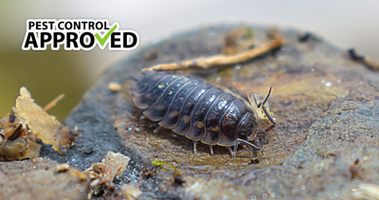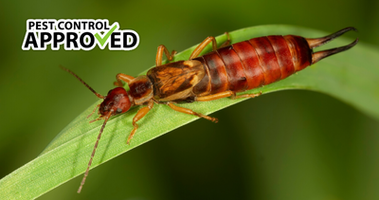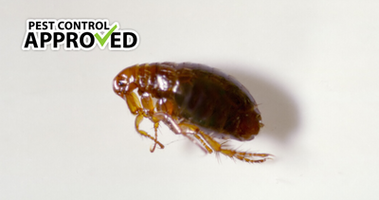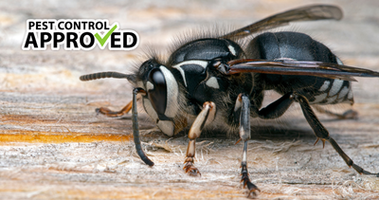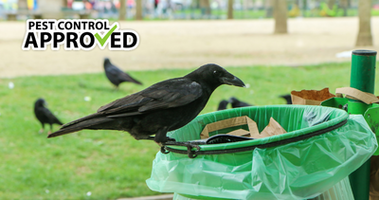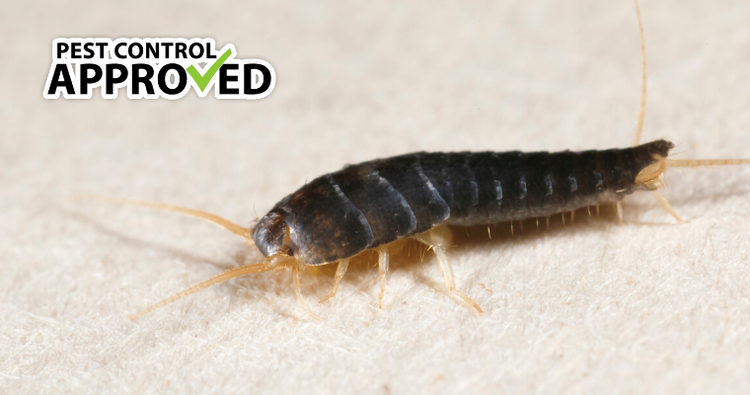
The Silverfish, Insect or Fish?
Have you ever noticed something dart across the washroom floor or run into the shadows as you turn on the light? Or have you ever felt something running across your arm but when you look down, nothing is there? Well, you might just have come across one of the oldest pests on earth, the silverfish. This creepy-crawly insect that has been around since the dinosaurs. It has existed for over 400 million years!
As the weather starts to get warmer, we tend to move around a bit more. People are not the only animals that become more active as the weather changes. Most household insects tend to resurface in spring.
Many people are terrified of spiders, wasps, or other various types of insects that surface as the weather changes. But many people also encounter unknown insects. There is one particular pest that often goes undetected. You may not want to read further if you get easily creeped out.
These particular pests are not bloodsuckers and do not carry viruses, but they are still problematic.
What Is A Silverfish?
They are not fish, despite their name. They are a small light grey, brownish grey, white, or silvery looking wingless insect that has a metallic-looking shine. Like many insects, it continues to shed its skin well into its adult life, and, as it ages, it grows fish-like scales. These scales protect the silverfish from other predators. The silverfish gets its name from these scales and its movement. It has a wriggling motion that makes its back end move side to side, similar to a fish moving its tail in the water.
Silverfish have two long cerci or antennae at the front of their bodies. These antennae are used for touch, smell, and taste. Unlike similar insects, they have eyes, but these eyes are highly sensitive to light. The body of a silverfish tapers, giving it an elongated teardrop shape. At the end of a silverfish, you will find three bristle or tail like appendages; silverfish are also known as "bristletails." This insect can be about 2cm (1/2 inch) to 2.5 cm (1 inch) in length. Its life span ranges from two to eight years, much more than other insects.
Even though they never evolved wings, they developed speed. As one of their defense, they can run fast and are resilient to many chemicals that are deadly to other pests.
Where Are They Commonly Found?
Chances are that you have silverfish in your home. Unlike other household pests, silverfish are common to all climates. Even then, their preferences run towards cooler temperatures in your home. They are fond of dark, damp places. They prefer places like washrooms, basements, laundry rooms, storage spaces, attics, and kitchen cabinets. Outside of the home, you will find them either in the soil or possibly in your garage or shed.
The other reason they are hard to spot is because they are nocturnal. During the day, you will find them hiding in the secluded recess of your home like in dark cabinet corners or under boxes. They prefer to look for food at night.
Since they are adept at scaling ceilings and walls, you can find them anywhere. They may even reside in the ceiling. There is no dark, moist place that they will not live in.
How Can You Tell if You Have Silverfish?
Since these household pests are nocturnal and extremely quick, it is challenging to tell if you have an infestation. It could be months before you notice an issue. Regardless, there are some telltale signs.
1) Damage to Household Items
One of the sure signs of a Silverfish infestation in your home is damage to various articles including books, clothing, wallpaper, upholstery, and cardboard boxes. The damage will be tiny holes made when silverfish eat the material.
2) Yellowish Stains
If you find yellowish stains on clothing, books, or your curtains, you might have silverfish. It is one sign that sets a silverfish infestation apart from other infestations.
3) Skin
Like most insects, silverfish shed their skin. But unlike most insects, silverfish continue to shed their skin well into adulthood. You can often find the skin on their ground in dark, moist areas. Since they are small, the skin will look like the husk of the bug. Their skin can also cause allergies in some people. See a doctor if you suddenly feel itchy or find little red dots forming your hands and arms.
4) Feces
Silverfish leave behind small droppings. Their droppings look like small flakes of pepper and are found wherever they live. Small droppings like pepper flakes can be signs of other insects such as fleas. Thus, droppings alone may not indicate the type of infestation present.
5) Seeing Silverfish
The most visible indicator of a silverfish problem is when you see many of them in your home. But since they are nocturnal, this can be difficult. Look for them in the evenings in low light.
How Do They Enter?
Since Silverfish prefer damp places, they can enter into your home through the surrounding soil. As the heat increases and dries out the soil, Silverfish will look for locations that offer more moisture and cooler temperatures.
Getting into homes isn't as hard as it may seem for these critters. If there are any cracks or small gaps in your foundation, they can squeeze through.
Seeing silverfish around should be taken seriously. They are a sign that you might have more significant in your home that need to be addressed. Depending on where you see them, you may have a significant leak, water damage in your walls or in your roof. If they are surfacing in your washroom or other parts of your home, it means they are being drawn to moisture. Look for cracks that are caused by water damage or mold.
Silverfish can easily be brought into your home. They have been known to travel in cardboard boxes into industrial sites and from there into your home. Chances are that if you bought storage boxes or if you were moving, you may have gained a guest you never knew about.
Silverfish reproduce rapidly. A Silverfish can lay between 50 and 200 eggs in single day. It takes these eggs anywhere from nineteen to forty-three days to hatch. Within a month, you could have a serious infestation.
What Do Silverfish Eat?
Part of the reason Silverfish are considered a household pest is because of their diet. They are fond of materials high in sugar, starch, carbohydrates, and protein. Some of the most common things they eat are:
- Books
- Drapes
- Cardboard boxes
- Clothing
- Glue
- Shampoo
- Silk
- Old photos
- Carpets
- Leather
- Sheets
- Blankets
- Paintings
- Paper documents
- Wallpaper
Are Silverfish Predators?
Although silverfish are pests, they will remove other household pests. They are cannibalistic and sometimes eat other insects. But they only eat ones that have been injured or are dead. Similarly, they also like to feed on their own kind that are injured or dead. They will even eat their own exoskeleton. Their preference for meat runs to dried beef or other human grade meat.
Do They Bite?
Silverfish don't bite, but they like to eat human hair and eyelashes. Surprisingly, they even eat dandruff. If you find them crawling on you at night, they might be looking for a snack.
How Long Can They Survive Without Food?
Silverfish can actually survive for weeks without food and water. Research has shown that they can survive on water alone for over 300 days! They unfortunately don't die quickly. This could be the reason they have survived for over millions of years.
Are They Harmful?
Beyond being an annoyance, silverfish are not dangerous. There is no evidence that silverfish carry viruses or diseases, unlike rodents and other pests. The only noticeable health effect they can cause is an allergic reaction. Silverfish shed their skin throughout their life. The skin they shed can cause for allergies in humans. The only other harm they cause is damage as they eat your possessions or homes.
How to Prevent a Silverfish Infestation
Preventing a silverfish infestation in your home is not as easy as it may seem. But it is easier than treating an infestation. Both require a thorough search of your home and strategically treating all the possible places they can breed in or live.
Food Sources
One of the best ways to help reduce the spread of Silverfish in your home is by eliminating their food sources. It isn't easy because they eat everything but keeping crumbs off the floor will help. Store all your dry items in sealed containers. Keeping your house super clean is not an easy task with kids, but it pays off. Consider vacuuming frequently to pick up dry skin, crumbs, and dead bugs.
Pesticides
There are numerous pesticides available. Many boast that they can kill any kind of household pest. But silverfish are resistant to many common pesticides. Some exterminators think that they may have built up a tolerance to various poisons over the centuries. Liquid Pyrethrin is one chemical spray that does work on silverfish. Still, it is not recommended if you have children or pets in the house, as it is toxic to them.
Most people would recommend contacting an exterminator who has experiences with Silverfish infestations and knows how to use strong chemicals effectively.
Dehumidifier
If you live in an area that has moist and cool basements, you can use a dehumidifier to reduce the dampness. Once the moisture is reduced, the area will be unappealing to silverfish. This also applies to vents and crawl spaces you might have in your homes. Using a dehumidifier for vents will help prevent a silverfish infestation. Airing such places out regularly will also make them less moist.
Exterior Places
Ensuring that exterior places are clean and dry is also essential. Use caulk around your doors, in crevices, and around windows. You should ensure that your exterior walls are painted and crack free. Cleaning debris out of eavestrough and drainpipes is also helpful. It is essential that the gutters around the home are clear so that the water keeps flowing. Trapped water or moist vegetation in drainpipes is an attractive home for silverfish.
Take the time to look over your screens and doors. Make sure there are no gaps in the door frames or tears in the screens that could allow insects into your home.
If you have wooden shingles on your roof, make sure that they are mold free. Wooden shingles tend to have mold, which is an ideal source of food for silverfish. If they continue eating the mold, they can cause damage to your roof.
Interior Spaces
Just like the outside your home, you should remove any possible silverfish habitats. If you have an unfinished basement, line it with plastic sheets. The plastic sheets help reduce and control the moisture in your basement, making it a less appealing to silverfish. Seal cracks under and behind baseboards. Check your windows and doors for any holes or cracks that might bring allow insects access to your home. Use expanding foam or caulk around pipe openings to reduce the chances of an infestation.
Non-Chemical Tricks
Cinnamon Sticks or Powder - One trick is to place cinnamon or cinnamon sticks in your house. The smell of cinnamon is a natural deterrent. Leave cinnamon in places where you have seen silverfish or by damp pipes. Make sure to replace the cinnamon regularly before it becomes damp.
Cedar Shavings – Tried and tested, cedar shavings have been used to keep pests at bay for centuries. They repel moths and they will do the same to silverfish. Cedar shavings can also be used outside your home to prevent pests from coming inside. Since it is biodegradable, the smell it releases as it degrades continues to help repel silverfish.
Bay Leaves – Similar to the cedar shavings and cinnamon, the oils released by dried bay leaves are a good repellant. Sprinkle dried bay leaves around your home or fill cloth bags with it and place them where you have seen silverfish.
Traps - Numerous traps can also be created. Use glass jars and bait them with starchy food. Then, seal the jar with the silverfish inside. If you don't have kids running around, try using sticky traps. They work great with rodents, but they also work with Silverfish. You can bait the traps or place them near dark, moist crevices.
Diatomaceous Earth – Sprinkle some of this in your cabinets to prevent or eliminate a silverfish infestation. Diatomaceous earth is made up of ground fossilized material. As an insect crawls over it, the sharp edges of the earth cut into their belly, killing them.
Cleaning
The ideal way to prevent an infestation of bugs, whether it is Silverfish or cockroaches, is to maintain a clean home. Unfortunately, dirty places tend to be a magnet for pests. That doesn't mean your home has to shine like the Mr. Clean commercials of old. But it is a good idea not to leave dirty dishes sitting around and make sure your counters and kitchen floors are clean. Get into the habit of not just vacuuming the floor but the furniture too. This helps to eliminate any possible food source for pests.
De-cluttering of homes is also essential. You might have a stack of old magazines that you think you might look over again but, those magazines are great homes for silverfish. They offer food and a great place to hide. Avoid keeping cardboard boxes or piles of clothing sitting in storage in your basement.
Silverfish Predators
As quick and as protected as silverfish are, they are still food for other predatory insects. Such insects include spiders, earwigs, and centipedes. Having them in your home may prevent a silverfish infestation, but these insects are also considered household pests. It depends on which pest you prefer.
Conclusion
As harmless as they are to humans, silverfish are a massive annoyance in homes. The damage they can do is astounding. So, keep your eyes open and take the necessary preventative measures to avoid having a silverfish infestation in your home.


